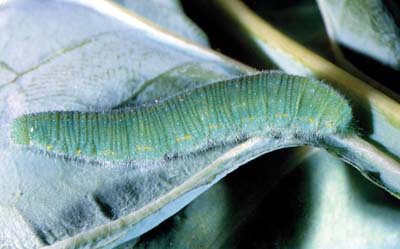
Imported cabbageworm, Pieris rapae, larva.
(Photographer: J. Capinera, University of Florida)
Vegetable crops that are commonly attacked include broccoli, Brussels sprouts, cabbage, cauliflower, collard, horseradish, kale, and kohlrabi. Damage is due to the feeding of the larvae. Populations are managed using insecticides based on samples that are taken in the field. Cultural control practices include row covers, paper caps, and host plant resistance. Biological control agents occur naturally in the field and help to keep populations at low levels.
Images
To save the Web-optimized images shown below to your hard drive:
|
Click to access Display and Print quality images. |
|
Click to access Display and Print quality images. |
|
Click to access Display and Print quality images. |
|
Click to access Display and Print quality images. |